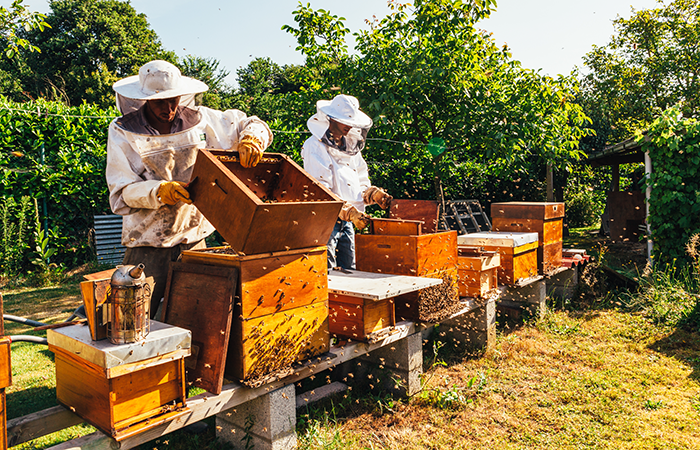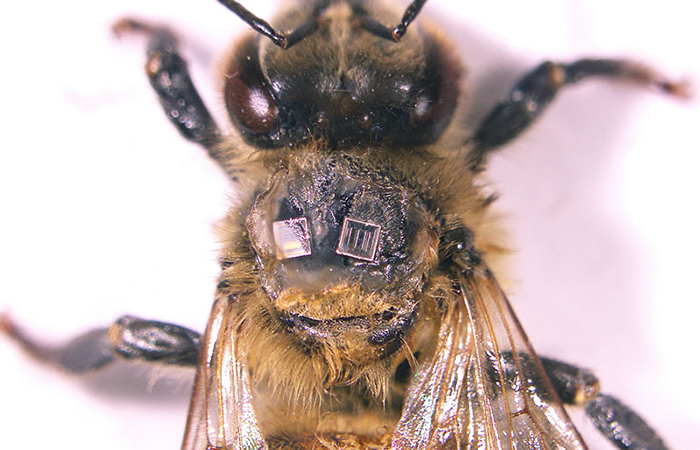RAIN RFID Opens a Window to the World of Honey Bees
RAIN RFID is helping scientists understand the lives of honey bees and how to better protect them.
Bees have run into some trouble in recent years. You’ve probably heard about bee colony collapse, and the dire consequences it might hold for our forests and food crops. Bees are a keystone of our ecology, and our survival is partly dependent on their survival. The many factors behind massive honey bee die-offs have entomologists realizing there is much to learn about bees before we can properly intervene on their behalf.

Where do honey bees go? What do they do all day? In the past, researchers painted colored dots on bees and tried to recognize individuals as they bumbled back to their hive entrance. This method is difficult and prone to error — the definition of an inexact science.
RAIN RFID is making the science more exact. Scientists have started attaching tiny RAIN RFID tags to the backs of bees to better understand their work habits and daily activity. A tag affixed to their thorax is so small the bees don’t seem to notice it, and tags don’t impede the bees’ movement. The bees don’t even realize they’re the stars of this research.
Researchers designed beehives so that bees must enter and exit through special openings, and are tracked as they pass beneath Impinj RAIN RFID readers. By installing RAIN RFID readers in hives, scientists can precisely count the bees coming and going, and log the precise times of their commutes. Colony insects always return to the same hive, mound, or anthill after foraging, so RAIN RFID is a perfect solution for tracking their movement.
[ Want to read more like this? Subscribe to the Impinj blog. ]
Through technologies like RAIN RFID, we are now living in a world full of interconnected things. These things — some of them very small — can be connected to the internet, forming what is known as the Internet of Things, or IoT. These beekeeping researchers connected the bees to the IoT and were able to “read” their movements as they went about their daily tasks
For example, researchers used RAIN RFID near Canberra, Australia, to study how bees can navigate over unfamiliar territory. The team tagged bees with RAIN RFID tags and drove them miles away from their hives before releasing them. The bees were essentially blindfolded — locked into boxes — so they couldn’t rely on anything but their own navigation ability to find their way back to the hive. Was it instinct that led them home? Some sort of signal or scent?

An interesting development occurred. Over the next few days, bees released within 6 kilometers of their hive to the north, south, and west returned, but those released farther than 6 kilometers away did not return. However, bees released to the east as far as 11 kilometers away did make their way back to their base. This wasn’t due to tailwinds aiding them in their flight.
Since bees typically fly at about 15 mph, scientists postulated that the bees had to spend a certain amount of time getting their bearings and plotting their way home, stopping about twice an hour to refuel somewhere along the way. Over 1,000 bees were tagged, and over one-third returned — 20% took more than 24 hours to check in, with some stragglers taking days to make the journey.
This has given scientists some exciting new information about the way bees think. Understanding more about the area that bees cover searching for pollen, and the ways that environmental factors can help or hinder their navigation, can help beekeepers decide the best locations for their hives and how best to protect them from threats.
This research was made possible only through RAIN RFID tagging; highly accurate headcounts would not have been possible without it. This is a lesson entomologists have taken to heart, and many more researchers have built projects with RAIN RFID tracking at their core.
Subsequently, their research methods have become more imaginative, and their findings more surprising:
- RAIN RFID was used to track bees during their mating season, revealing for the first time that queens leave the hive several times during this period.
- RAIN RFID tracking revealed that honeybees work harder before rainy days.
- RAIN RFID allows scientists to observe the entire life of a bee for detailed study.
- RAIN RFID tracking showed that chemical stressors reduce “elite” forager populations in bee colonies, causing a reduction in food production over time.
- RAIN RFID enabled researchers to observe drone activity at dawn and during the early morning, behavior never seen in earlier studies.
The secrets of the complicated, exotic world of bees are finally being revealed through the use of RAIN RFID and the IoT. It just goes to show that if RAIN RFID can track something as small and unpredictable as a bee, it can be used to track just about anything.
Learn about some of the many uses of RAIN RFID and more about the Internet of Things with the Impinj platform.
Monday, May 16, 2022
ABOUT THE AUTHOR

Tom Dougherty
Senior Copywriter
Tom Dougherty brings a breadth of experience writing, illustrating, and otherwise creating content for tech and entertainment companies.
Sign Up for the latest news
